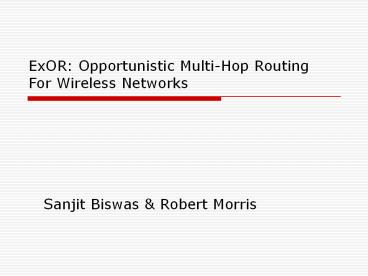ExOR: Opportunistic Multi-Hop Routing For Wireless Networks - PowerPoint PPT Presentation
Title:
ExOR: Opportunistic Multi-Hop Routing For Wireless Networks
Description:
This paper contributes the first complete design and implementation of a link ... Gradual falloff of probability with distance (80%, 40%, 20 ... – PowerPoint PPT presentation
Number of Views:226
Avg rating:3.0/5.0
Title: ExOR: Opportunistic Multi-Hop Routing For Wireless Networks
1
ExOR Opportunistic Multi-Hop Routing For
Wireless Networks
- Sanjit Biswas Robert Morris
2
Contributions
- This paper contributes the first complete design
and implementation of a link/network-layer
diversity routing technique that uses standard
radio hardware. - It demonstrates a substantial throughput
improvement over traditional routing.
3
Why ExOR promises high throughput? (1)
4
Why ExOR promises high throughput? (2)
N5
N1
N3
N7
N6
N2
N4
N8
S
D
Traditional Path
- Gradual falloff of probability with distance
(80, 40, 20..) - Lucky longer path can reduce transmission count
- Shorter path ensures some forward progress
- ExOR works better with local interference than
global
5
Four Design Challenges
- The nodes must agree on which subset of them
received each packet - A metric to measure the probable cost of moving
packet from any node to destination - Choosing most useful participants
- Avoid simultaneous transmission to minimize
collisions
6
Node State
- Packet buffer
- Forwarding timer
- Transmission tracker
- Used to adjust forwarding tracker.
- Batch map
- Highest priority node that received the pkt
7
Working
N7
N8
F
F
F
N1
N2
N5
S
F
N4
D
Batch
N3
N6
F
1st round
2nd round
3rd round
8
Cost Metric similar to ETX
- ETX Expected Transmission Count
- ExOR uses forward delivery probability
- Knowledge of inter-node loss rate
9
Evaluation Setup
- 38 Roofnet nodes participated using 802.11b
- One hop at a time for fair comparison in
traditional routing.
10
Evaluation 1A
- Bars higher than 1000 indicates that nodes had
to transmit the packet more than once.
11
Evaluation 1B
- ExOR exhibits better throughput
12
Evaluation - 2
13
Summary
- Pros
- ExOR achieves 2x to 4x throughput improvement for
more distant pairs - ExOR implemented on Roofnet and evaluated in
detail - Exploits radio properties, instead of hiding them
- Does not require changes in the MAC layer
- Cons
- Not scalable to large network as traditional
routing - Overhead in packet header (batch info)
- Batches affect the TCP performance
- What if not enough packets to make the batch?































